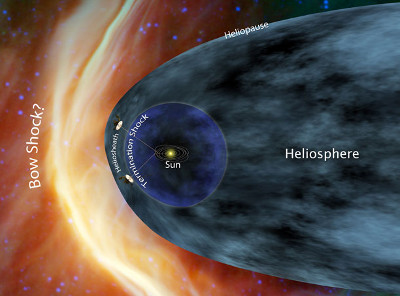Voyager 1 groped the boundary of the solar system
 Voyager 1 - automatic probe, launched in 1977, reached the borders of the heliosphere. The heliosphere is a region of the near-solar space where the solar wind still prevails over the “galactic wind” —the flow of particles of the interstellar medium. Two years ago, the device entered the heliopause zone, where the pressure of the solar wind balances the pressure of the interstellar medium. In June of this year, Voyager sensors registered a sharp increase in the level of galactic cosmic rays - the device came out from under the protection of the solar wind.
Voyager 1 - automatic probe, launched in 1977, reached the borders of the heliosphere. The heliosphere is a region of the near-solar space where the solar wind still prevails over the “galactic wind” —the flow of particles of the interstellar medium. Two years ago, the device entered the heliopause zone, where the pressure of the solar wind balances the pressure of the interstellar medium. In June of this year, Voyager sensors registered a sharp increase in the level of galactic cosmic rays - the device came out from under the protection of the solar wind.Voyager 1 is located at a distance of 121 astronomical units (18 billion kilometers) from the Sun and moves at a speed of 17 kilometers per second. It is the most remote from the Earth and the fastest object ever built by man. The radio signal from Voyager reaches Earth in 16 hours and 38 minutes.

At long distances from the Sun, solar batteries, which are familiar to near-earth vehicles, are useless. The energy source for Voyager are three radioisotope thermoelectric generators. As the fuel decays, their power decreases. The main mission of Voyager-1 - the study of the outer planets of the solar system - was successfully completed in 1989. Since then, to save energy, NASA is gradually shutting down sensors and devices, without which you can do without. The latest Voyager systems are expected to last until 2025–2030. Now the power of "batteries" is about 300 watts.
')
There are 6 computer modules on board Voyager (3 systems, each of which is duplicated). The total amount of memory on board is 68 kilobytes. The memory is used on a magnetic wire - a kind of memory on magnetic cores, in which, instead of ferrite ringlets, sections of the wire with a special coating are magnetized.
The Command System (Computer Command System - CCS) and the Position and Articulation Control System (AACS) are used to control the Voyager and deal with emergency situations. Each of them has 4096 18-bit words. Flight Data System (FDS) manages science equipment and data transmission to Earth. It has 8198 16-bit words.
In addition, there is a tape memory for scientific data and a gold plated plate with recordings of world music, sounds of nature, human voices welcoming a potential audience of aliens in 55 of the most common languages of the Earth, and 116 images of people, landscapes, scientific charts and diagrams.

Considering the conditions in which Voyager systems operate and the complete impossibility of repair and maintenance (with the exception of reprogramming several thousand memory cells over the air at 16 bits per second and “ping” at 33 hours), this is one of the most reliable and durable electronic devices ever either created by man.
More information about the Voyager program, including data from its sensors and the exact position and speed, can be found on the official website of the project.
Source: https://habr.com/ru/post/146003/
All Articles